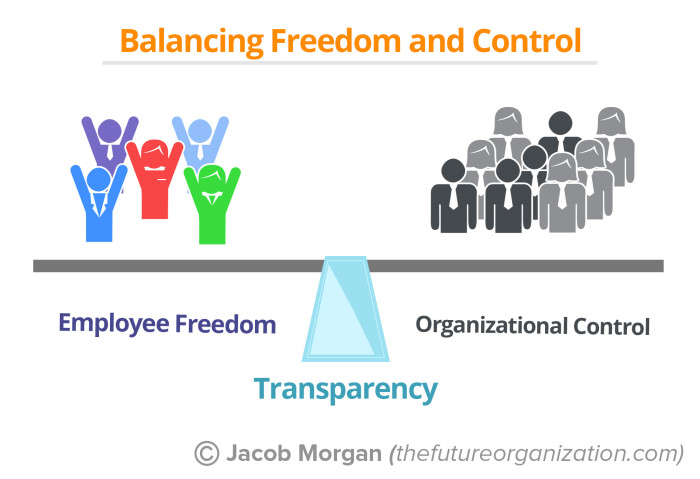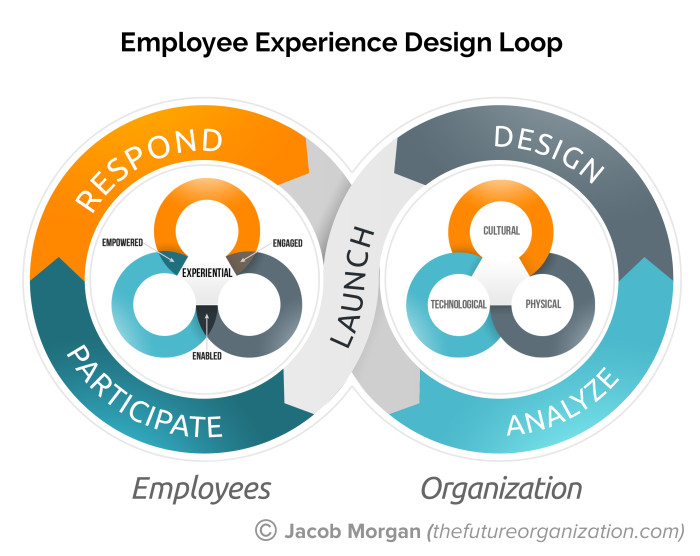When looking at something such as designing employee experiences one of the biggest questions and challenges that comes up is how to balance employee freedom with organizational control. There is no such thing as a single employee experience, there are many of them. In order to design employee experiences the organization and the employee have to participate in something I call, The Employee Experience Design Loop, which you can see below. I wrote an entire article about this which you can also read called, A Framework For How Any Organization Can Design Amazing Employee Experiences.
But in this type of a model there is a bit of a give and take. Essentially employees provide feedback on what they care about and value and the organization takes that information and designs experiences around it. For this to work there needs to be some kind of balance. Not everything that the employees want can be implemented, after all, organizations should’t be expected or required to create “Pinocchio’s island.” On the other hand it’s also quite clear that what most organizations are doing today isn’t working. So if employees can’t have everything they want but the organization still needs to bend and adapt while making sure that business goals are being met and that actual work is getting done, how does that happen? The answer is in the image below.
As you can see the key here is transparency. This is what allows the balance between employee freedom and organizational control to exist. A great example of this actually comes not from the inside of an organization but from the outside (customer centric) with Starbucks. Starbucks launched something a while ago called My Starbucks Idea which allows customers from around the world to suggest ideas and improvements to the coffee giant. These ideas can be around products, experiences, or event community involvement and sustainability. As you can imagine Starbucks gets A LOT of ideas on a regular basis and there is no way that they can possibly implement every idea that comes there way (just like an organization can’t possibly implement every employee idea around experience), so what do they do? They share as much information as they can.
Starbucks allows customers to vote on the ideas that they would most like to see implemented. Starbucks then takes those most popular ideas and evaluates them but they do so in an open way. Customers can see which ideas are most popular, which ideas are under review, ideas that have already been reviewed, ideas that are coming soon, and those that have already been launched. Not only that but if Starbucks tries out an idea that doesn’t work, they will explain why. For example, a while ago Starbucks implemented a customer idea which allowed guests to get into a separate line if they just wanted to pick up a plain ‘ol regular coffee (do people even drink those anymore?). After all, why should you have to wait in line while people order their double soy non-fat decaf vanilla chai lattes with an extra pump of vanilla when all you want is just black coffee, something that takes just a few seconds to pour. While Starbucks tried this out and it failed. It was too confusing to customers and causes all sorts of problems, so Starbucks went back to their customers and let them know what happened and why. Guess what, customers were ok with it. They didn’t get out the pitch forks because Starbucks was open and transparent with them. I talked about this a bit more in the video below as well.
Many organizations focus on designing experiences for employees instead of designing experiences with employees. We need to stop being scared about sharing and opening up information. You cannot design great employee experiences and balance employee freedom with organizational control without transparency.
Now imagine if your organization took the Starbucks approach to designing employee experiences. Imagine being able to tell your employees what you are working to create better employee experiences and why. What would it be like if you were able to experiment with ideas and then report back to your employees on what you are working on to create an environment where people will truly WANT to show up, not where they NEED to show up? That would truly be an organization worth working for.
Jacob Morgan is a keynote speaker, author, and futurist. You can invite Jacob to keynote your next conference, subscribe to his videos on Youtube, check our his podcast, or subscribe to his newsletter!

